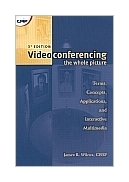|
||
• wydawnictwa polskie
• Zamów informacje o nowościach z wybranego tematu • kontakt
• Cookies na stronie |
VIDEOCONFERENCING THE WHOLE PICTUREWILCOX J.wydawnictwo: CMP , rok wydania 2000, wydanie IIIcena netto: Videoconferencing Terms Concepts Applications and Interactive Multimedia
This book is about an emerging communications tool; videoconferencing, and the applications that are built upon it. Videoconferencing and interactive multimedia represent an aggregation of technologies that includes information coding and compression, telecommunications and networking, broadcasting, and end-user presentational and data manipulation tools. The field of interactive multimedia and videoconferencing is not new, but it is rapidly evolving. In preparing this book, I seek to present clearly and concisely the complex subject of videoconferencing. It is helpful but not necessary that the reader know a little about videoconferencing and about networking. I start with the basics to build a foundation with which the reader can grasp the elementary issues. My intent is to spend equal time on technology, standards, and applications. In all cases, I want the reader to understand the business implications of interactive multimedia and videoconferencing. Selling a solution, even if it is in an organization's best interest, requires that. It is my position that the purpose of technology, as fascinating as it is, is to serve human needs. For those who are new to the topic, this book will serve as a good introduction to the various forms of video communications. For the technically advanced, it will provide information for understanding and assessing new products, staying abreast of standards, and refining expertise. In any case, I encourage the reader to explore ways to implement video communications to enhance collaboration, facilitate competitive strategies, improve information delivery, and increase efficiency. Interactive video communications strategies can be significant enablers in the construction of applications that span multiple geographic locations, and even organizational (e.g., corporate or governmental) boundaries. These applications include group-to-group meetings, person-to-person desktop, videophone, one-to-many broadcasts and multicasts, point-to-point and multipoint data collaboration, and variations thereof. One should adapt combinations and implementations of these applications to suit specific organizational or personal needs. Some of the more successful application categories include telemedicine," distance learning, telecommuting and site-to-site collaboration, legal and judicial, joint engineering, diplomatic relations, and negotiations and more additional examples than one can list! Strong needs-analysis, ingenuity, and senior management support can make practically any video communications application successful. 610 pages Księgarnia nie działa. Nie odpowiadamy na pytania i nie realizujemy zamówien. Do odwolania !. |


